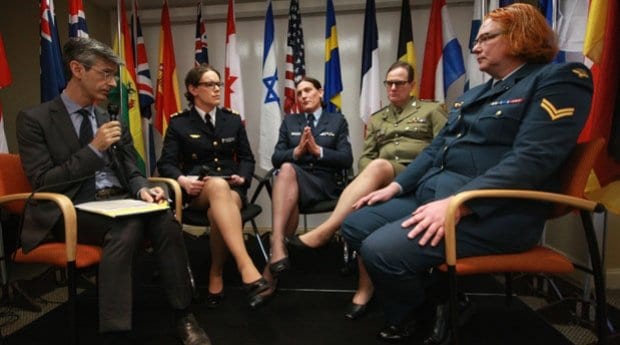Transgender military personnel from Canada and around the world descended on Washington, DC, Oct 20 to share their experiences, network and inform policy-makers in the United States.
The packed room of approximately 75 people included transgender military members from the United Kingdom, Australia, New Zealand, Sweden and the US (the latter were a mix of those who retired, were forced out or have served while keeping their transgender identity a secret).
Speaking from the Canadian perspective was Natalie Murray, 49, a corporal in the Royal Canadian Air Force who has 27 years of military experience and currently serves in Comox, BC.
“I don’t want people to have to deal with what I’ve had to deal with,” Murray says, explaining that she transitioned from male to female in 2003, almost a decade before official guidelines and policy directives were implemented in the Canadian Armed Forces for transgender service members.
Canada was invited to speak at the conference, held just a few blocks from the White House, because it is recognized as a leader for its LGBT-inclusionary military policies. In early 2012, it published a document called “Management of CF Transsexual Members” that provides guidance specifically for transgender service members and military leadership.
Even with policies in place, however, key issues continued to surface during the conference that included the need for unified support from leadership at all levels, stricter measures for privacy concerns, and innovative training to promote greater awareness of LGBT diversity — especially transgender content — in the workplace.
In Canada, the policy is currently being amended, according to Lieutenant-Commander Nicole Lassaline, a policy spokesperson at the conference.
“More thorough consultation with the target population is a big lesson learned for us,” Lassaline said, adding that feedback from transgender service members as well as senior leaders is important for developing policies that are effective.
Lassaline was followed by Allan Okros, a professor at the Royal Military College of Canada who recently published a report that found the inclusion of transgender personnel had no impact on the operational effectiveness of the Canadian military.
“You need good policy, you need effective leadership, and you need education,” Okros said, adding that part of the challenge is that militaries have profound social norms and behaviours that don’t typically favour people who stand out as different.
“Militaries need to move to loosen culture,” he said, noting that accepting differences is key to a professional service that respects the dignity of all people. “The military is about building effective, cohesive teams. You won’t have it if people are feeling discriminated against, no matter what the reasons.”
As distinguished guests took their turns at the front of the room, a backdrop of 19 national flags was visible behind them. Eighteen of them represent the countries that currently allow transgender personnel to serve in the military, based on research by The Hague Centre for Strategic Studies, a policy institute in the Netherlands.
In 2013, the institute examined more than 100 countries and published the world’s first ranking of LGBT-inclusion among armed forces. The result is an LGBT Military Index based on factors such as the existence of official policy documents, public statements made by politicians and the presence of openly serving transgender personnel in the armed forces.
Despite ranking 40th on the index, the American flag was placed in the centre of the room as a symbolic focus of the conference.
“Trans military service works, and we have examples from around the world,” said Aaron Belkin, director of the Palm Center, which organized the conference in partnership with the American Civil Liberties Union. “Helping people in the US and Washington to understand that message is what’s next.”
Although the Don’t Ask, Don’t Tell policy was repealed in 2010, the Pentagon continues to prohibit transgender people from serving openly in the US military.
The most recent changes in the US came in the summer of 2014 when President Obama signed an executive order that protects federal employees and contractors from discrimination based on their gender identity.
“If that had been signed back in 2007, I would have had recourse,” says Sheri Swokowski, 64, who served in the US Army’s infantry and retired in 2004 as a high-ranking colonel. She waited until her retirement and transitioned in her mid-50s yet was still fired from a contractor job in 2007.
According to a recent article published by the Washington Blade, a review of the trans military ban may be stalled, casting doubt on whether Obama will overturn it before presidential elections take place in November 2016.
What was clear from the conference is that people are tired of waiting.
Representing former members of the US military, Landon Wilson is a 24-year-old veteran who served in the Navy and was forced to leave when commanders discovered he is transgender.
“‘We’re overacting because we have absolutely no idea what to do with you,’” Wilson remembers being told by a superior after he was sent home from Afghanistan.
“At the same time they’re handing me awards; they’re processing my discharge papers,” Wilson says, recalling that he had been recently promoted and recognized for outstanding service at the time.
Former US Navy SEAL Kristin Beck, with 20 years of service and 13 deployments under her belt, also spoke at the conference. Her reason for attending: she’s still fighting for equality and freedom in her own country.
“I can still [serve] as a female,” she says. “I’m still me, no matter what I wear. I still have the capability to kick ass.”

 Why you can trust Xtra
Why you can trust Xtra


